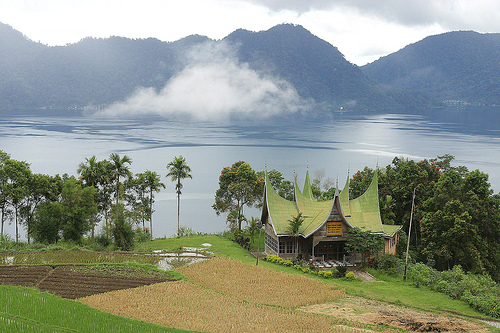Nestled in the highlands of West Sumatra, Indonesia, Lake Maninjau offers travelers a serene escape surrounded by breathtaking landscapes and rich cultural heritage. This volcanic lake, formed over centuries, is not only a natural wonder but also a hub of Minangkabau culture, providing visitors with a unique blend of outdoor adventures and traditional experiences. From tranquil boat rides to exploring nearby villages, Lake Maninjau promises an unforgettable journey into the heart of Indonesia’s highlands.
Activities Around Lake Maninjau
Scenic Views and Photography Spots
Lake Maninjau is renowned for its panoramic vistas. The combination of calm waters, lush greenery, and surrounding hills creates a perfect setting for photography enthusiasts. One of the best vantage points is the Kelok 44 hill road, where visitors can capture sweeping views of the lake winding through the highlands. Early mornings and late afternoons provide the softest lighting, ideal for landscape shots or simply soaking in the natural beauty.
Boating and Fishing
For those who enjoy water activities, boating across Lake Maninjau offers both relaxation and adventure. Traditional wooden boats, operated by local fishermen, provide a serene experience while observing the daily life of villagers along the shore. Fishing is another popular activity, as the lake is home to a variety of freshwater fish species. Visitors can join locals in fishing trips or simply enjoy a peaceful afternoon casting lines from the lakeside.
Cycling and Hiking Around the Lake
The area surrounding Lake Maninjau is perfect for cycling and hiking enthusiasts. The lake’s perimeter is encircled by winding roads with moderate elevation changes, offering both a physical challenge and stunning views. Hikers can explore nearby hills and trails, encountering waterfalls, rice terraces, and unique flora along the way. For cyclists, the descent from the Maninjau viewpoint is particularly thrilling, providing both adrenaline and picturesque scenery.
Culinary Experiences
Exploring Lake Maninjau is incomplete without indulging in Minangkabau cuisine. Local restaurants and roadside stalls serve specialties such as ikan mas arsik (spicy carp dish), rendang (slow-cooked beef in coconut milk and spices), and gulai daun singkong (cassava leaves in coconut gravy). These dishes reflect the rich culinary heritage of the Minang people, emphasizing bold flavors and fresh ingredients sourced from the lake and surrounding lands.
Experiencing Local Culture
Traditional Villages
The villages around Lake Maninjau offer a glimpse into Minangkabau culture. Characterized by iconic rumah gadang (traditional houses with curved roofs), these settlements maintain centuries-old architectural and social traditions. Visitors can interact with villagers, learn about local crafts, and witness cultural performances during special ceremonies. The matrilineal system of the Minangkabau people, where property and family names are inherited through the female line, is a unique aspect that fascinates anthropologists and tourists alike.
Cultural Festivals
Several cultural events take place throughout the year in the Lake Maninjau region. Traditional dance performances, such as Tari Piring (Plate Dance), often accompany ceremonies and local festivals. These dances showcase precision, rhythm, and storytelling through graceful movements and intricate footwork. Participating or observing these festivals allows travelers to experience the vibrant traditions that have been preserved for generations.
Handicrafts and Souvenirs
Local artisans around Lake Maninjau create beautiful handicrafts that reflect the cultural heritage of the area. Weaving, wood carving, and traditional embroidery are commonly practiced skills, and visitors can purchase handmade souvenirs directly from the creators. Supporting these artisans not only helps sustain local traditions but also provides travelers with meaningful keepsakes from their journey.
Eco-Tourism and Sustainable Travel
Lake Maninjau is increasingly becoming a model for eco-tourism in Indonesia. Visitors are encouraged to respect the natural environment and local communities. Many accommodations follow sustainable practices, such as minimizing plastic usage and promoting local food sourcing. Guided tours often emphasize environmental education, explaining the importance of preserving the lake’s delicate ecosystem, including its flora and fauna. Responsible travel ensures that future generations can continue to enjoy Lake Maninjau’s beauty and cultural richness.
Community Involvement
The local communities around Lake Maninjau actively participate in tourism management. Homestays and small guesthouses are often family-run, offering authentic experiences and personalized hospitality. Tourists can engage in daily activities with residents, such as rice planting, traditional cooking, or even participating in local rituals. This approach not only benefits the community economically but also fosters cultural exchange and mutual understanding between visitors and hosts.
Baca Juga: Viral Electric Bike Kids in Jakarta
Practical Tips for Visiting Lake Maninjau
-
Getting There: The nearest major city is Bukittinggi, approximately 36 kilometers from Lake Maninjau. Visitors can take private cars, motorbikes, or local buses to reach the lake. The journey offers scenic views of hills and valleys.
-
Best Time to Visit: The dry season, from April to October, is ideal for outdoor activities, offering clear skies and calm lake waters. Early mornings are particularly recommended for photography and boating.
-
Accommodation: Options range from lakeside resorts to budget-friendly homestays. Booking in advance is advised, especially during local festivals or holidays.
-
Local Etiquette: Dress modestly when visiting villages and respect cultural norms, such as asking permission before photographing people or religious sites. Engaging politely with locals will enhance your experience and foster goodwill.
-
Health and Safety: Bring sufficient water, sun protection, and insect repellent. While the area is generally safe, basic precautions during hiking or boating are recommended.
Conclusion
Exploring Lake Maninjau is more than a scenic getaway—it is a journey into the heart of Minangkabau culture and natural beauty. Whether you are seeking adventure, relaxation, or cultural immersion, the lake offers activities and experiences to suit every traveler. From the tranquil waters to the vibrant local traditions, a visit to Lake Maninjau promises memories that will last a lifetime.
Breathe in the fresh highland air, savor authentic Minangkabau cuisine, and immerse yourself in a rich cultural landscape that continues to thrive alongside nature. Lake Maninjau stands as a testament to Indonesia’s diverse heritage and breathtaking natural wonders, offering travelers a truly holistic experience.
